Strategi Pengembangan Wisata Tradisi Ojhung Berbasis Sport Tourism di Kabupaten Sumenep
DOI:
https://doi.org/10.26740/jossae.v5n2.p83-93Keywords:
ojhung, sport tourism, tourism development strategyAbstract
Sumenep Regency is known for its diverse cultures, one of which is Ojhung. Ojhung is the ritual performed as a request for rain. Ojhung is the art of fighting by hitting and fending off opponents using rattan guided by referees. Ojhung traditional art has the potential to be developed into cultural-based sport tourism, which combines sports activities with the strength of Ojhung traditional art. In line with the tourism sector which is the flagship in Sumenep. Evident from the inauguration of Sumenep as œSoul of Madura. This research aims to describe the development strategies of Ojhung tourism based on sport tourism in Sumenep Regency. This study used qualitative method. Data collection techniques in the form of observation, in-depth interviews, and literature studies. Data analyzed used SWOT, EFAS, and IFAS analysis. The data validity checking technique uses triangulation. Ojhung can be develop to be sport tourism in Sumenep Regency because it has a tourist attraction, based on the criteria among others: the ritual of request for rain and Ojhung competition, which visitors can participate in the Ojhung competition.
References
Downloads
Published
How to Cite
Issue
Section
 Abstract views: 685
,
Abstract views: 685
, PDF Downloads: 1007
PDF Downloads: 1007









